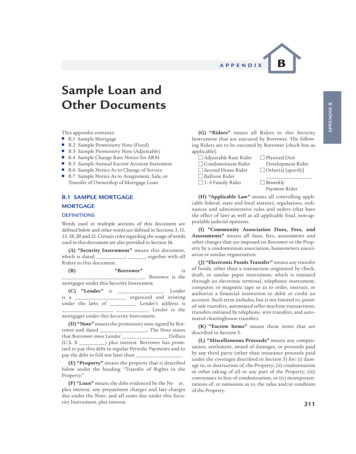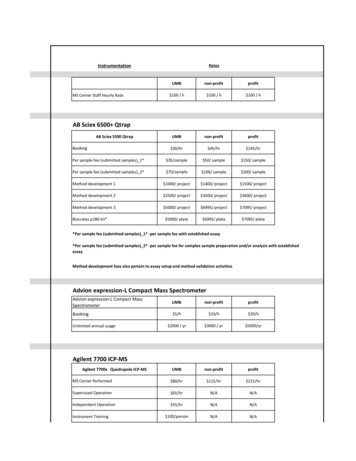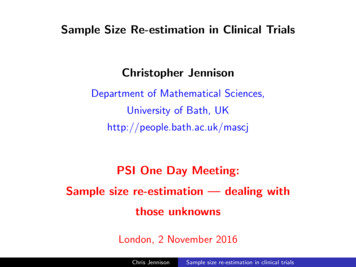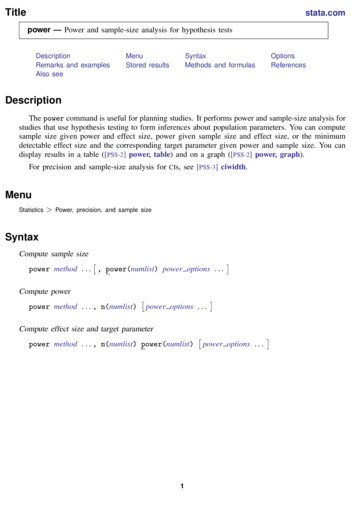
Transcription
010213030405Determining the Sample Size060708091011121314Hain’t we got all the fools in town on our side? and aint that a big enough majority in any town?Mark Twain, Huckleberry FinnNothing comes of nothing.15Shakespeare, King 3940414243444513.1BACKGROUNDClinical trials are expensive, whether the cost is counted in money or in human suffering,but they are capable of providing results which are extremely valuable, whether thevalue is measured in drug company profits or successful treatment of future patients.Balancing potential value against actual cost is thus an extremely important and delicate matter and since, other things being equal, both cost and value increase the morepatients are recruited, determining the number needed is an important aspect of planning any trial. It is hardly surprising, therefore, that calculating the sample size isregarded as being an important duty of the medical statistician working in drug development. This was touched on in Chapter 5 and some related matters were also consideredin Chapter 6. My opinion is that sample size issues are sometimes over-stressed at theexpense of others in clinical trials. Nevertheless, they are important and this chapterwill contain a longer than usual and also rather more technical background discussionin order to be able to introduce them properly.All scientists have to pay some attention to the precision of the instruments withwhich they work: is the assay sensitive enough? is the telescope powerful enough?and so on are questions which have to be addressed. In a clinical trial many factorsaffect precision of the final conclusion: the variability of the basic measurements, thesensitivity of the statistical technique, the size of the effect one is trying to detect, theprobability with which one wishes to detect it if present (power), the risk one is preparedto take in declaring it is present when it is not (the so-called ‘size’ of the test, significancelevel or type I error rate) and the number of patients recruited. If it be admitted that thevariability of the basic measurements has been controlled as far as is practically possible,that the statistical technique chosen is appropriately sensitive, that the magnitude ofthe effect one is trying to detect is an external ‘given’ and that a conventional type Ierror rate and power are to be used, then the only factor which is left for the trialist to464748Statistical Issues in Drug Development/2nd Edition 2007 John Wiley & Sons, LtdAugust 14, 200721:30Stephen SennWiley/SIDDPage-195c13
ng the Sample Sizemanipulate is the sample size. Hence, the usual point of view is that the sample size isthe determined function of variability, statistical method, power and difference sought.In practice, however, there is a (usually undesirable) tendency to ‘adjust’ other factors,in particular the difference sought and sometimes the power, in the light of ‘practical’requirements for sample size.In what follows we shall assume that the sample size is going to be determined as afunction of the other factors. We shall take the example of a two-arm parallel-group trialcomparing an active treatment with a placebo for which the outcome measure of interestis continuous and will be assumed to be Normally distributed. It is assumed that analysiswill take place using a frequentist approach and via the two independent-samples t-test. Aformula for sample size determination will be presented. No attempt will be made to deriveit. Instead we shall show that it behaves in an intuitively reasonable manner.We shall present an approximate formula for sample size determination. An exactformula introduces complications which need not concern us. In discussing the samplesize requirements we shall use the following conventions: : the probability of a type I error, given that the null hypothesis is true. : the probability of a type II error, given that the alternative hypothesis is true. : the difference sought. (In most cases one speaks of the ‘clinically relevant difference’and this in turn is defined ‘as the difference one would not like to miss’. The ideabehind it is as follows. If a trial ends without concluding that the treatment iseffective, there is a possibility that that treatment will never be investigated againand will be lost both to the sponsor and to mankind. If the treatment effect isindeed zero, or very small, this scarcely matters. At some magnitude or other ofthe true treatment effect, we should, however, be disturbed to lose the treatment.This magnitude is the difference we should not care to miss.) : the presumed standard deviation of the outcome. (The anticipated value of themeasure of the variability of the outcomes from the trial.)n: the number of patients in each arm of the trial. (Thus the total number is 2n.)The first four basic factors above constitute the primitive inputs required to determinethe fifth. In the formula for sample size, n is a function of and , that is tosay, given the values of these four factors, the value of n is determined. The functionis, however, rather complicated if expressed in terms of these four primitive inputs andinvolves the solution of two integral equations. These equations may be solved usingstatistical tables (or computer programs) and the formula may be expressed in terms ofthese two solutions. This makes it much more manageable. In order to do this we needto define two further terms as follows.Z /2 :Z :this is the value of the Normal distribution which cuts off an upper tail probabilityof /2. (For example if 0 05 then Z /2 1 96.)this is the value of the Normal distribution which cuts off an upper tail probabilityof . (For example, if 0 2, then Z 0 84.)We are now in a position to consider the (approximate) formula for sample size,which is45n 2 Z /2 Z 2 2 / 2 464748(13.1)(N.B. This is the formula which is appropriate for a two-sided test of size . See chapter 12for a discussion of the issues.)August 14, 200721:30Wiley/SIDDPage-196c13
Background1970102Power: That which statisticians are always calculating but never mple 13.1It is desired to run a placebo-controlled parallel group trial in asthma. The target variableis forced expiratory volume in one second FEV1 . The clinically relevant difference ispresumed to be 200 ml and the standard deviation 450 ml. A two-sided significancelevel of 0.05 (or 5%) is to be used and the power should be 0.8 (or 80%). What shouldthe sample size be?Solution: We have 200 ml 450 ml 0 05 so that Z /2 1 96 and 1 0 8 0 2 and Z 0 84. Substituting in equation (13.1) we have n 2 450 ml 2 1 96 0 84 2 / 200 ml 2 79 38. Hence, about 80 completing patients per treatment arm arerequired.It is useful to note some properties of the formula. First, n is an increasing functionof the standard deviation , which is to say that if the value of is increased so mustn be. This is as it should be, since if the variability of a trial increases, then, otherthings being equal, we ought to need more patients in order to come to a reasonableconclusion. Second, we may note that n is a decreasing function of : as increases ndecreases. Again this is reasonable, since if we seek a bigger difference we ought to beable to find it with fewer patients. Finally, what is not so immediately obvious is that ifeither or decreases n will increase. The technical reason that this is so is that thesmaller the value of , the higher the value of Z /2 and similarly the smaller the valueof , the higher the value of Z . In common-sense terms this is also reasonable, sinceif we wish to reduce either of the two probabilities of making a mistake, then, otherthings being equal, it would seem reasonable to suppose that we shall have to acquiremore information, which in turn means studying more patients.In fact, we can express (13.1) as being proportional to the product of two factors,writing it as n 2F1 F2 . The first factor, F1 Z /2 Z 2 depends on the error ratesone is prepared to tolerate and may be referred to as decision precision. For a trial with10% size and 80% power, this figure is about 6. (This is low decision precision). For1% size and 95% power, it is about 18. (This would be high decision precision.) Thusa range of about 3 to 1 covers the usual values of this factor. The second factor,F2 2 / 2 , is specific to the particular disease and may be referred to as applicationambiguity. If this factor is high, it indicates that the natural variability from patient topatient is high compared to the sort of treatment effect which is considered important.It is difficult to say what sort of values this might have, since it is quite different fromindication to indication, but a value in excess of 9 would be unusual (this means thestandard deviation is 3 times the clinically relevant difference) and the factor is notusually less than 1. Putting these two together suggests that the typical parallel-grouptrial using continuous outcomes should have somewhere between 2 6 1 12 and2 18 9 325 patients per arm. This is a big range. Hence the importance of decidingwhat is indicated in a given case.In practice there are, of course, many different formulae for sample size determination.If the trial is not a simple parallel-group trial, if there are more than two treatments, ifthe outcomes are not continuous (for example, binary outcomes, or length of survivalAugust 14, 200721:30Wiley/SIDDPage-197c13
1980102030405060708Determining the Sample Sizeor frequency of events), if prognostic information will be used in analysis, or if the objectis to prove equivalence, different formulae will be needed. It is also usually necessary tomake an allowance for drop-outs. Nevertheless, the general features of the above hold.A helpful tutorial on sample size issues is the paper by Steven Julious in Statisticsin Medicine (Julious, 2004); a classic text is that of Desu and Raghavarao (1990).Nowadays, the use of specialist software for sample size determination such as NQuery,PASS or Power and Precision is common.We now consider the issues.09101113.2ISSUES121313.2.1In practice such formulae cannot be 373839404142434445464748The simple formula above is adequate for giving a basic impression of the calculationsrequired to establish a sample size. In practice there are many complicating factorswhich have to be considered before such a formula can be used. Some of them presentsevere practical difficulties. Thus a cynic might say that there is a considerable disparitybetween the apparent precision of sample size formulae and our ability to apply them.The first complication is that the formula is only approximate. It is based on theassumption that the test of significance will be carried out using a known standarddeviation. In practice we do not know the standard deviation and the tests which weemploy are based upon using an estimate obtained from the sample under study. Forlarge sample sizes, however, the formula is fairly accurate. In any case, using the correct,rather than the approximate, formula causes no particular difficulties in practice.Nevertheless, although in practice we are able to substitute a sample estimate forour standard deviation for the purpose of carrying out statistical tests, and althoughwe have a formula for the sample size calculation which does take account of thissort of uncertainty, we have a particular practical difficulty to overcome. The problemis that we do not know what the sample standard deviation will be until we haverun the trial but we need to plan the trial before we can run it. Thus we have tomake some sort of guess as to what the true standard deviation is for the purpose ofplanning, even if for the purpose of analysis this guess is not needed. (In fact, a furthercomplication is that even if we knew what the sample standard deviation would be forsure, the formula for the power calculation depends upon the unknown ‘true’ standarddeviation.) This introduces a further source of uncertainty into sample size calculationwhich is not usually taken account of by any formulae commonly employed. In practicethe statistician tries to obtain a reasonable estimate of the likely standard deviationby looking at previous trials. This estimate is then used for planning. If he is cautioushe will attempt to incorporate this further source of uncertainty into his sample sizecalculation either formally or informally. One approach is to use a range of reasonableplausible values for the standard deviation and see how the sample size changes. Anotherapproach is to use the sample information from a given trial to construct a Bayesianposterior distribution for the population variance. By integrating the conditional power(given the population variance) over this distribution for the population variance, anunconditional (on the population variance) power can be produced from which a samplesize statement can be derived. This approach has been investigated in great detail bySteven Julious (Julious, 2006). It still does not allow, however, for differences from trialAugust 14, 200721:30Wiley/SIDDPage-198c13
9to trial in the true population variance. But it at least takes account of pure samplingvariation in the trial used for estimating the population standard deviation (or variance)and this is an improvement over conventional approaches.The third complication is that there is usually no agreed standard for a clinicallyrelevant difference. In practice some compromise is usually reached between ‘true’clinical requirements and practical sample size requirements. (See below for a moredetailed discussion of this point.)Fourth, the levels of and are themselves arbitrary. Frequently the values chosenin our example (0.05 and 0.20) are the ones employed. In some cases one mightconsider that the value of ought to be much lower. In some diseases, where there aresevere ethical constraints on the numbers which may be recruited, a very low valueof might not be acceptable. In other cases, it might be appropriate to have a lower. In particular it might be questioned whether trials in which is lower than arejustifiable. Note, however, that is a theoretical value used for planning, whereas isan actual value used in determining significance at analysis.It may be a requirement that the results be robust to a number of alternative analyses.The problem that this raises is frequently ignored. However, where this requirementapplies, unless the sample size is increased to take account of it, the power will bereduced. (If power, in this context, is taken to be the probability that all required testswill be significant if the clinically relevant difference applies.) This issue is discussed insection 13.2.12 below.22232413.2.225By adjusting the sample size we can fix our probability of s statement is not correct. It must be understood that the fact that a sample sizehas been chosen which appears to provide 80% power does not imply that there is an80% chance that the trial will be successful, because even if the planning has beenappropriate and the calculations are correct:(i) The drug may not work. (Actually, strictly speaking, if the drug doesn’t work wewish to conclude this, so that failure to find a difference is a form of success.)(ii) If it works it may not produce a clinically relevant difference.(iii) The drug might be better than planned for, in which case the power should behigher than planned.(iv) The power (sample size) calculation covers the influence of random variation onthe assumption that the trial is run competently. It does not allow for ‘acts of God’or dishonest or incompetent investigators.Thus although we can affect the probability of success by adjusting the sample size, wecannot fix it.42434413.2.345The sample size calculation is an excuse for a sample size andnot a reason464748There are two justifications for this view. First, usually when we have sufficient background information for the purpose of planning a clinical trial, we already have a goodAugust 14, 200721:30Wiley/SIDDPage-199c13
4252627Determining the Sample Sizeidea what size of trial is indicated. For example, so many trials now have been conductedin hypertension that any trialist worth her salt (if one may be forgiven for mentioningsalt in this context) will already know what size the standard trial is. A calculation ishardly necessary. It is a brave statistician, however, who writes in her trial protocol,‘a sample size of 200 was chosen because this is commonly found to be appropriatein trials of hypertension’. Instead she will usually feel pressured to quote a standarddeviation, a significance level, a clinically relevant difference and a power and applythem in an appropriate formula.The second reason is that this calculation may be the final result of several hiddeniterations. At the first pass, for example, it may be discovered that the sample size ishigher than desirable, so the clinically relevant difference is adjusted upwards to justifythe sample size. This is not usually a desirable procedure. In discussing this one should,however, free oneself of moralizing cant. If the only trial which circumstances permitone to run is a small one, then the choice is between a small trial or no trial at all. It isnot always the case that under such circumstances the best choice, whether taken inthe interest of drug development or of future patients, is no trial at all. It may be useful,however, to calculate the sort of difference which the trial is capable of detecting sothat one is clear at the outset about what is possible. Under such circumstances, thevalue of can be the determined function of and n and is then not so much theclinically relevant as the detectable difference. In fact there is a case for simply plottingfor any trial the power function: that is to say, the power at each possible value of theclinically relevant difference. A number of such functions are plotted in Figure 13.1 forthe trial in asthma considered in Example 13.1. (For the purposes of calculating thepower in the graph, it has been assumed that a one-sided test at the 2.5% level willbe carried out. For high values of the clinically relevant difference, this gives the sameanswer as carrying out a two-sided test at the 5% level. For lower values it is preferableanyway.)282930313220033134350.8 0.8Power363738n 400.5n 8039n 16040410.025420434445464748200Clinically relevant difference400Figure 13.1 Power as a function of clinically relevant difference for a two-parallel-group trialin asthma. The outcome variable is FEV1 , the standard deviation is assumed to be 450 ml, and nis the number of patients per group. If the clinically relevant difference is 200 ml, 80 patients pergroup are needed for 80% power.August 14, 200721:30Wiley/SIDDPage-200c13
Issues0113.2.4020304201If we have performed a power calculation, then upon rejectingthe null hypothesis, not only may we conclude that thetreatment is effective but also that it has a clinically relevanteffect0506070809101112This is a surprisingly widespread piece of nonsense which has even made its way intoone book on drug industry trials. Consider, for example, the case of a two parallelgroup trial to compare an experimental treatment with a placebo. Conventionally wewould use a two-sided test to examine the efficacy of the treatment. (See Chapter 12for a discussion. The essence of the argument which follows, however, is unaffected bywhether one-sided or two-sided tests are used.) Let be the true difference (experimentaltreatment–placebo). We then write the two hypotheses,13H0 014H1 0 (13.2)151617181920212223242526Now, if we reject H0 , the hypothesis which we assert is H1 , which simply states thatthe treatment difference is not zero or, in other words, that there is a difference betweenthe experimental treatment and placebo. This is not a very exciting conclusion but ithappens to be the conclusion to which significance in a conventional hypothesis testleads. As we saw in Chapter 12, however (see section 13.2.3), by observing the signof the treatment difference, we are also justified in taking the further step of decidingwhether the treatment is superior or inferior to placebo. A power calculation, however,merely takes a particular value, , within the range of possible values of given byH1 and poses the question: ‘if this particular value happens to obtain, what is theprobability of coming to the correct conclusion that there is a difference?’ This does notat all justify our writing in place of (13.2),2728H0 0H1 (13.3)H0 0H1 (13.4)2930or even313233343536373839404142434445464748In fact, (13.4) would imply that we knew, before conducting the trial, that the treatmenteffect is either zero or at least equal to the clinically relevant difference. But wherewe are unsure whether a drug works or not, it would be ludicrous to maintain thatit cannot have an effect which, while greater than nothing, is less than the clinicallyrelevant difference.If we wish to say something about the difference which obtains, then it is better toquote a so-called ‘point estimate’ of the true treatment effect, together with associatedconfidence limits. The point estimate (which in the simplest case would be the differencebetween the two sample means) gives a value of the treatment effect supported by theobserved data in the absence of any other information. It does not, of course, haveto obtain. The upper and lower 1 confidence limits define an interval of valueswhich, were we to adopt them as the null hypothesis for the treatment effect, wouldnot be rejected by a hypothesis test of size . If we accept the general Neyman–Pearsonframework and if we wish to claim any single value as the proven treatment effect, thenit is the lower confidence limit, rather than any value used in the power calculation,which fulfills this role. (See Chapter 4.)August 14, 200721:30Wiley/SIDDPage-201c13
202010213.2.5Determining the Sample SizeWe should power trials so as to be able to prove that a clinicallyrelevant difference obtains030405Suppose that we compare a new treatment to a control, which might be a placebo ora standard treatment. We could set up a hypothesis test as follows:0607H0 08H1 313233343536373839404142434445464748H0 asserts that the treatment effect is less than clinically relevant and H1 that it is atleast clinically relevant. If we reject H0 using this framework, then, using the logic ofhypothesis testing, we decide that a clinically relevant difference obtains. It has beensuggested that this framework ought to be adopted since we are interested in treatmentswhich have a clinically relevant effect.Using this framework requires a redefinition of the clinically relevant difference. It isno longer ‘the difference we should not like to miss’ but instead becomes ‘the differencewe should like to prove obtains’. Sometimes this is referred to as the ‘clinically irrelevantdifference’. For example, as Cairns and Ruberg point out (Cairns and Ruberg, 1996;Ruberg and Cairns, 1998), the CPMP guidelines for chronic arterial occlusive diseaserequire that, ‘an irrelevant difference (to be specified in the study protocol) betweenplacebo and active treatment can be excluded’ (Committee for Proprietary MedicinalProducts, 1995). In fact, if we wish to prove that an effect equal to obtains, thenunless for the purpose of a power calculation we are able to assume an alternativehypothesis in which is greater than , the maximum power obtainable (for an infinitesample size) would be 50%. This is because, in general, if our null hypothesis is that , and the alternative is that , the critical value for the observed treatmentdifference must be greater than . The larger the sample size the closer the critical valuewill be to , but it can never be less than . On the other hand, if the true treatmentdifference is , then the observed treatment difference will less than in approximately50% of all trials. Therefore, the probability that it is less than the critical value mustbe greater than 50%. Hence the power, which is the probability under the alternativehypothesis that the observed difference is greater than the critical value, must be lessthan 50%.The argument in favour of this approach is clear. The conventional approach tohypothesis testing lacks ambition. Simply proving that there is a difference betweentreatments is not enough: one needs to show that it is important. There are, however,several arguments against using this approach. The first concerns active controlledstudies. Here it might be claimed that all that is necessary is to show that the treatmentis at least as good as some standard. Furthermore, in a serious disease in which patientshave only two choices for therapy, the standard and the new, it is only necessary toestablish which of the two is better, not by how much it is better, in order to treatpatients optimally. Any attempt to prove more must involve treating some patientssuboptimally and this, in the context, would be unacceptable.A further argument is that a nonsignificant result will often mean the end of the roadfor a treatment. It will be lost for ever. However, a treatment which shows a ‘significant’effect will be studied further. We thus have the opportunity to learn more about itseffects. Therefore, there is no need to be able to claim on the basis of a single trial thata treatment effect is clinically relevant.August 14, 200721:30Wiley/SIDDPage-202c13
Issues0113.2.6203Most trials are unethical because they are too 42526272829The argument is related to one in Section 13.2.5. If we insist on ‘proving’ that a newtreatment is superior to a standard we shall study more patients than are necessaryto obtain some sort of belief, even it is only a mere suspicion, that one or the othertreatment is superior. Hence doctors will be prescribing contrary to their beliefs and thisis unethical.I think that for less serious non-life-threatening and chronic diseases this argumentis difficult to sustain. Here the patients studied may themselves become the futurebeneficiaries of the research to which they contribute and, given informed consent, thereis thus no absolute requirement for a doctor to be in equipoise. For serious diseases theargument must be taken more seriously and, indeed, sequential trials and monitoringcommittees are an attempt to deal with it. The following must be understood, however.(1) Whatever a given set of trialists conclude about the merits of a new treatment, mostphysicians will continue to use the standard for many years. (2) In the context of drugdevelopment, a physician who refuses to enter patients on a clinical trial because sheor he is firmly convinced that the experimental treatment is superior to the standardtreatment condemns all her or his patients to receive the standard. (3) if a trial stopsbefore providing reasonably strong evidence of the efficacy of a treatment, then evenif it looks promising, it is likely that collaborating physicians will have considerabledifficulties in prescribing the treatment to future patients.It thus follows that, on a purely logical basis at least, a physician is justified incontinuing on a trial, even where she or he believes that the experimental treatmentis superior. It is not necessary to start in equipoise (Senn, 2001a, 2002). The trialmay then be regarded as continuing either to the point where evidence has overcomeinitial enthusiasm for the new treatment, so that the physician no longer believesin its efficacy, or to the point at which sceptical colleagues can be convinced thatthe treatment works. Looked at in these terms, few conventional trials would betoo large.3031323313.2.7Small trials are unethical343536373839404142434445464748The argument here is that one should not ask patients to enter a clinical trial unlessone has a reasonable chance of finding something useful. Hence small or ‘inadequatelypowered’ trials are unethical.There is something in this argument. I do not agree, however, that small trials areuninterpretable and, as was explained in Section 13.2.2, sometimes only a small trialcan be run. It can be argued that if a treatment will be lost anyway if the trial is notrun, then it should be run, even if it is only capable of ‘proving’ efficacy where thetreatment effect is considerable. Part of the problem with small trials is, to use Altmanand Bland’s memorable phrase, that ‘absence of evidence is not evidence of absence’(Altman and Bland, 1995) and there is a tendency to misinterpret a nonsignificanteffect as an indication that a treatment is not effective rather than as a failure to provethat it is effective. However, if this is the case, it is an argument for improving medicaleducation, rather than one for abandoning small trials. The rise of meta-analysis hasalso meant that small trials are becoming valuable for the part which they are able toAugust 14, 200721:30Wiley/SIDDPage-203c13
2040102Determining the Sample Sizecontribute to the whole. As Edwards et al. have argued eloquently, some evidence isbetter than none (Edwards et al., 1997).03040506Clinically relevant difference: Used in the theory of clinical trials as opposedto cynically relevant difference, which is used in practice.0708091013.2.811A significant result is more meaningful if obtained from a largetrial1213141516171
13 14 21 30 Determining the Sample Size










